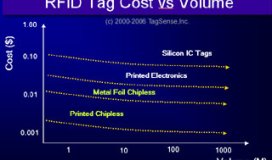In this article, we’ll discuss how and where RFID fits in shrink reduction strategies.
RFID technology provides item-level visibility throughout the supply chain, and we know how that visibility improves inventory accuracy from 65% to a staggering 95%. Accurate and real-time information is essential to companies who have adopted an omni-channel retailing strategy, but an added benefit often left out of the discussion is RFID loss prevention.
Loss Intelligence in the Supply Chain
Whenever RFID is used in the supply chain, you receive a larger return-on-investment when RFID tags are affixed as near the manufacturing source as possible. The item-level visibility gives you the location and date-stamps of goods as it moves throughout the distribution process. Knowing when and where your products arrive and leave distribution centers is an important tool to curtail shrinkage in the supply chain.
The FBI pegs cargo theft as a multi-billion dollar criminal industry. Organized crime rings steal cargo, sometimes directly from the warehouses, and sell them online across various websites such as eBay. With RFID tagged items, identifying the stolen items becomes a faster process giving law enforcement a better opportunity to act quickly. Also, a well designed system will reveal the exact time when the tagged items left the distribution center, and inventory can properly be adjusted to accommodate for the stolen cargo. So while RFID may not prevent cargo theft, it will provide valuable, actionable information which can be used to improve weak points in the supply chain and potentially identify the thieves.
RFID Theft Prevention in Retail Stores
Item-level RFID tagging makes daily inventory counts a realistic task, and companies like American Apparel have readily embraced RFID throughout their supply chain all the way to the retail store. The real-time and accurate data has improved their logistics strategies, but American Apparel noticed another added benefit. Shrinkage in their stores dropped by an average of 55%, and some stores saw shrinkage drop by 75%. It turns out that employees were largely responsible for a significant portion of shrinkage.
Employee theft accounts for 43% of all retail shrinkage. When inventory is tracked in real-time, employees are no longer able to easily steal products as the source of the theft would be quickly linked to the employees working during that shift. From there, it would be a quick process of elimination to identify the culprit.
When RFID, point-of-sale, and electronic article surveillance (EAS) technologies are all incorporated, loss intelligence greatly improves due to the availability of shared data throughout the integrated system. RFID provides inventory visibility and keeps stock levels accurate, but when integrated with the POS and EAS system, companies can identify which items exited the store without being purchased. Besides providing valuable data to loss prevention teams, the store can adjust their inventory accordingly. Also, if someone attempts to return the stolen item, the POS and RFID system will be able to identify that item as being stolen.
Key Take-aways about RFID and Loss Prevention
While RFID is not a strong deterrent for limiting the success of shoplifters at the time of theft, the item-level visibility will drastically reduce employee theft.
1.Source tagging items provides a larger ROI as cargo can be tracked early in the distribution process.
2.The near real-time data is beneficial to loss prevention teams as it helps identify shrinkage patterns.
3.Integrating RFID, POS, and EAS systems will provide the most loss intelligence data.



